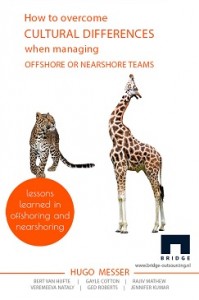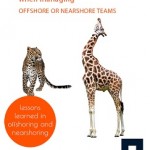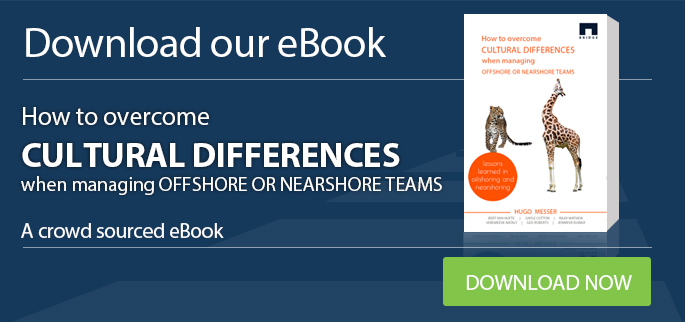How to Overcome Cultural differences when Managing Offshore or Nearshore teams?Hoe Culturele verschillen te overkomen bij het managen van Offshore of Nearshore teams?
 We recently launched our new eBook about offshoring and nearshoring : How to Overcome Cultural differences when Managing Offshore or Nearshore teams
We recently launched our new eBook about offshoring and nearshoring : How to Overcome Cultural differences when Managing Offshore or Nearshore teams
In the world of offshoring and global collaboration, there is no topic that is more widely discussed that cultural differences. Or maybe there is one: communication. People with experience in managing remote teams often cite communication as their biggest challenge. But what is communication? And if communication is the problem, where do we start the solution? In most cases, one of the best starting point is ‘culture’ (the others being people and process, which we describe in our other books).
The goal of this book is to give you practical insights on how to manage cultural differences when managing offshore or nearshore teams. Culture is a ‘soft’ topic, more a concept than something driven by analytics and data. There is no step by step ‘how to’ approach to deal with cultural differences. The only thing to do for people working with other cultures, is to learn as much as possible about the other culture. To make this learning effective, this book presents articles on how to understand culture on a more general level as well as real life experiences on cultural differences for a specific country. All authors come from different backgrounds and write from their own experience.
In the first chapter, Bert van Hijfte, a Dutch culture trainer specialised in Indian culture, writes about culture and communication in the outsourcing industry. Bert has trained many teams at companies like HCL, Aegon, Achmea, in various countries around the world. An industry veteran, he describes the way the outsourcing industry evolved in the past decades and how the current world of high attrition, influences the cultural divide. He cites the famous book of Hofstede and uses this to explain how to approach the cultural differences.
Chapter two is written by a famous cross cultural author from the US, Gayle Cotton. She has written a bestseller ‘SAY Anything to Anyone, Anywhere! 5 Keys to Successful Cross-Cultural Communication’. Gayle describes a global ‘etiquette’, a set of guidelines for behavior across different cultures.
Chapter three is written by Rajiv Mathew, head of Marketing at Compassites Software . He is a hands-on technology marketing & communications professional with proven expertise in multiple facets of the marketing spectrum. Rajiv describesvarious Cultural aspects in international business.
In the forth chapter, I describe the magic of ‘empathy’ to bridge cultural differences. Based on my own experience, I see a mismatch between technologists and empathy. I describe on what levels (team, company, product, culture) stimulating empathy can improve the odds that globally distributed teams succeed.
Chapter five is written by Natalya Veremeeva. Natalya lives in Ukraine and has worked for several outsourcing providers from Ukraine. She writes a story from the heart about her perception on Ukrainian (and in the broader sense: Soviet) culture. The guidelines she gives make it easier for any Western company to understand the intricacies of Eastern Europe.
Ged Roberts, describes the cultural differences between Dutch and Indians in chapter 6. As a native Brit, he can reflect on the differences from a ‘neutral’ perspective. He zooms in to some specifics about each culture, which we can use in our daily collaboration between India and the Netherlands.
Chapter 7 is written by Jennifer Kumar who, originally from the US, lives in India since 2011. Jennifer organizes many trainings for Indians about the US culture. In the article, she gives guidelines on how to effectively give and use trainings. This gives us insights in getting the maximum value from a training and gives trainers details to pay attention to while giving a training.
This is the forth eBook in a series of eBooks that will be published within a couple of months’ interval and later on into one printed book. These eBooks are being written through a crowdwriting project and the authors are experts from all over the world. We would appreciate your review on Amazon.
If you are interested in the upcoming eBooks or are an experienced practitioner who would like to contribute with your knowledge, please send an e-mai to h.messer@bridgeoutsourcing.nl
 We hebben recent ons nieuwe eBook over offshoring en nearshoring gelanceerd: Hoe Culturele verschillen te overkomen bij het managen van Offshore of Nearshore teams.
We hebben recent ons nieuwe eBook over offshoring en nearshoring gelanceerd: Hoe Culturele verschillen te overkomen bij het managen van Offshore of Nearshore teams.
In de wereld van offshoring en wereldwijde samenwerking is er geen onderwerp meer besproken dan de culturele verschillen. Of misschien is er wel een: communicatie. Mensen met ervaring in het managen van afgelegen teams noemen communicatie vaak als hun grootste uitdaging. Maar wat is communicatie? En als communicatie het probleem is, waar beginnen we dan met de oplossing? In de meeste gevallen is een van de beste beginpunten ‘cultuur’ (de andere zijn mensen en processen, die in onze andere boeken beschreven worden).
Het doel van dit boek is om u praktisch inzicht te geven in het managen van culturele verschillen wanneer u offshore of nearshore teams leidt. Cultuur is een ‘soft’ onderwerp, meer een concept dan iets wat onderbouwd wordt door analytici en data. Er is geen stap-voor-stap ‘hoe werkt het’ benadering om met culturele verschillen om te gaan. Het enige wat mensen die werken met mensen uit een andere cultuur kunnen doen, is om zoveel mogelijk te leren over de andere cultuur. Om dit leren effectief te maken, presenteert dit boek artikelen over hoe een cultuur te begrijpen op een meer algemeen niveau, maar ook real-life ervaring in culturele verschillen voor een specifiek land. Alle auteurs hebben verschillende achtergronden en schrijven vanuit hun eigen ervaring.
In het eerste hoofdstuk schrijft Bert van Hijfte, een Nederlandse cultuurtrainer gespecialiseerd in de Indiase cultuur, over cultuur en communicatie in de outsourcingindustrie. Bert heeft vele teams getraind in bedrijven als HCL, Aegon en Achmea in verschillende landen over de hele wereld. Als een industrieveteraan beschrijft hij de manier waarop de outsourcingindustrie geëvolueerd is in de afgelopen decennia en hoe de huidige wereld van snel natuurlijk verloop, het culturele gat beïnvloedt. Hij citeert uit het beroemde boek van Hofstede en gebruikt dit om uit te leggen hoe culturele verschillen benaderd moeten worden.
Hoofdstuk twee is geschreven door een beroemde cross-cultureschrijver uit de US, Gayle Cotton. Zij is de schrijfster van bestseller ‘SAY Anything to Anyone, Anywhere! 5 Keys to Successful Cross-Cultural Communication’. Gayle beschrijft een algemene ‘etiquette’, een set van richtlijnen voor gedrag tussen verschillende culturen.
Hoofdstuk drie is geschreven door Rajiv Mathew, hoofd Marketing bij Compassites Software. Hij is een hands-on technologiemarketing & communicatie professional met bewezen expertise in verschillende facetten van het marketingspectrum. Rajiv beschrijft verschillende Culturele aspecten in internationale bedrijven.
In het vierde hoofdstuk beschrijf ik de magie van ‘empathie’ om de culturele verschillen te overbruggen. Gebaseerd op mijn eigen ervaringen, zie ik een wanverhouding tussen technologen en empathie. Ik beschrijf op welk niveau (team, bedrijf, product, cultuur) het stimuleren van empathie de kans kan vergroten dat wereldwijd verspreide teams succesvol zijn.
Hoofdstuk vijf is geschreven door Natalya Veremeeva. Natalia woont in Oekraïne en heeft voor verschillende outsourcing aanbieders in Oekraïne gewerkt. Ze schrijft een verhaal vanuit het hart over haar perceptie van de Oekraïense (en in bredere zin: Sovjet) cultuur. De richtlijnen die ze geeft maken het makkelijker voor ieder Westers bedrijf om de ingewikkeldheden van Oost-Europa te begrijpen.
Ged Roberts beschrijft de cultuurverschillen tussen Nederlanders en Indiërs in hoofdstuk 6. Als geboren Brit, kan hij reflecteren op de verschillen vanuit een ‘neutraal’ perspectief. Hij zoomt in op enkele bijzonderheden van beide culturen, welke we kunnen gebruiken in onze dagelijkse samenwerking tussen India en Nederland.
Hoofdstuk 7 is geschreven door Jennifer Kumar die, origineel komend uit de US, in India heeft gewoond sinds 2011. Jennifer organiseert vele trainingen voor Indiërs over de Amerikaanse cultuur. In het artikel geeft ze richtlijnen voor het effectief geven en gebruik van trainingen. Dit geeft ons inzicht in het behalen van de maximale waarde uit een training en geeft trainers details om aandacht aan te schenken tijdens het geven van een training.
Dit is het vierde eBook in een serie van eBooks die gepubliceerd zijn binnen een paar maanden en later gebundeld zullen worden in één geprint boek. Deze eBooks worden geschreven door middel van een crowdwrighting project en de auteurs zijn experts van over de hele wereld. We zouden het waarderen als u een review wilt schrijven op Amazon.
Als u geïnteresseerd bent in toekomstige eBooks of als u een ervaren beoefenaar bent die graag bij zou willen dragen met uw kennis, stuur dan alstublieft een e-mail naar h.messer@bridge-outsourcing.nl



